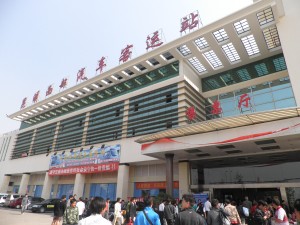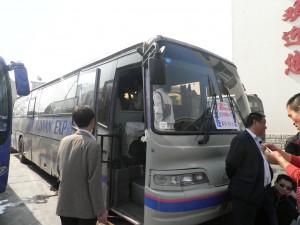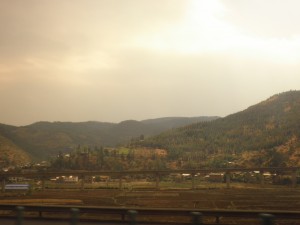ChongQing Day 2, China
Most days, ChongQing is covered by fog. The city is also called WuDu, the capital of fog.
![P4206534 [640x480]](http://journey26.com/blog/wp-content/uploads/2010/04/P4206534-640x480-300x225.jpg)
Ate XiaoMian (3Yuan~USD$0.50) for breakfast, a typical local food.
![P4206513 [640x480]](http://journey26.com/blog/wp-content/uploads/2010/04/P4206513-640x480-300x225.jpg)
There are a few museums located around ChaoTianMen bus station, just within walking distance from the YangTze River hostel. Visited the ChongQing famous people museum which is free.
![P4206517 [640x480]](http://journey26.com/blog/wp-content/uploads/2010/04/P4206517-640x480-300x225.jpg)
There was a short movie about how the Japanese was trying to bomb the city during the war. Even till today, most people in the city still have an anti Japanese sentiment and there are still many bunkers in the city.
A long painting hanging on the wall
![P4206519 [640x480]](http://journey26.com/blog/wp-content/uploads/2010/04/P4206519-640x480-300x225.jpg)
Because there was an Russian artist exhibition, got a promotional ticket for 10 Yuan to get in the ChongQing Urban Planning museum.
![P4206525 [640x480]](http://journey26.com/blog/wp-content/uploads/2010/04/P4206525-640x480-300x225.jpg)
The museum is about plans to develop the city. The current mayor of the city is BoXiLai. The guy was also the mayor for Dalian few years back, and the city Dalian also has a similar Urban Planning Museum.
View ChongQing in a larger map
The average per capita income has been increasing for the past few years. However, the income for rural population is still lagging behind the per capital income for the city population.
![P4206521 [640x480]](http://journey26.com/blog/wp-content/uploads/2010/04/P4206521-640x480-300x225.jpg)
The plan of One Circle with 2 Wings. The objective is to use the city (an area of one hour economic circle) to lead the development of the rural area.
![P4206526 [640x480]](http://journey26.com/blog/wp-content/uploads/2010/04/P4206526-640x480-300x225.jpg)
The museum was pretty interactive with a lot of videos and multimedia equipments.
Took bus 265 to CiQiKou
![P4206535 [640x480]](http://journey26.com/blog/wp-content/uploads/2010/04/P4206535-640x480-300x225.jpg)
which is an old town of ChongQing.
![P4206538 [640x480]](http://journey26.com/blog/wp-content/uploads/2010/04/P4206538-640x480-300x225.jpg)
![P4206539 [640x480]](http://journey26.com/blog/wp-content/uploads/2010/04/P4206539-640x480-300x225.jpg)
Like most other old towns in China, the town has become touristy with many shops selling souvenirs and food catering to visitors.
![P4206553 [640x480]](http://journey26.com/blog/wp-content/uploads/2010/04/P4206553-640x480-300x225.jpg)
There were also a few Indian Roti shop.
![P4206552 [640x480]](http://journey26.com/blog/wp-content/uploads/2010/04/P4206552-640x480-300x225.jpg)
Got back to the RenMinDaLiTang.
![P4206558 [640x480]](http://journey26.com/blog/wp-content/uploads/2010/04/P4206558-640x480-300x225.jpg)
tried to visit the three Gorges museum but it was already closed. The latest time to enter is 4pm.
Took bus 338 to YangRenJie which has some structures from other countries.
![P4206567 [640x480]](http://journey26.com/blog/wp-content/uploads/2010/04/P4206567-640x480-300x225.jpg)
Everywhere there are constructions going on.
![P4206571 [640x480]](http://journey26.com/blog/wp-content/uploads/2010/04/P4206571-640x480-300x225.jpg)
Took bus 321 back to JieFangBei. Food in ChongQing has some similarities with Sichuanese cuisine, except that it’s not that numbing. ChongQing is famous for its hot and spicy HotPot.
![P4206572 [640x480]](http://journey26.com/blog/wp-content/uploads/2010/04/P4206572-640x480-300x225.jpg)
Met up with Phoebe whom I met at the hostel in Chengdu for hotpot dinner, together with her friends.
![P4206530 [640x480]](http://journey26.com/blog/wp-content/uploads/2010/04/P4206530-640x480-300x225.jpg)
![P4206563 [640x480]](http://journey26.com/blog/wp-content/uploads/2010/04/P4206563-640x480-225x300.jpg)
![P4206576 [640x480]](http://journey26.com/blog/wp-content/uploads/2010/04/P4206576-640x480-300x225.jpg)
![P4206575 [640x480]](http://journey26.com/blog/wp-content/uploads/2010/04/P4206575-640x480-300x225.jpg)
![P4196467 [640x480]](http://journey26.com/blog/wp-content/uploads/2010/04/P4196467-640x480-300x225.jpg)
![P4196470 [640x480]](http://journey26.com/blog/wp-content/uploads/2010/04/P4196470-640x480-300x225.jpg)
![P4196474 [640x480]](http://journey26.com/blog/wp-content/uploads/2010/04/P4196474-640x480-300x225.jpg)
![P4196475 [640x480]](http://journey26.com/blog/wp-content/uploads/2010/04/P4196475-640x480-300x225.jpg)
![P4196477 [640x480]](http://journey26.com/blog/wp-content/uploads/2010/04/P4196477-640x480-300x225.jpg)
![P4196481 [640x480]](http://journey26.com/blog/wp-content/uploads/2010/04/P4196481-640x480-300x225.jpg)
![P4196491 [640x480]](http://journey26.com/blog/wp-content/uploads/2010/04/P4196491-640x480-225x300.jpg)
![P4196493 [640x480]](http://journey26.com/blog/wp-content/uploads/2010/04/P4196493-640x480-300x225.jpg)
![P4196494 [640x480]](http://journey26.com/blog/wp-content/uploads/2010/04/P4196494-640x480-300x225.jpg)
![P4196488 [640x480]](http://journey26.com/blog/wp-content/uploads/2010/04/P4196488-640x480-225x300.jpg)
![P4196498 [640x480]](http://journey26.com/blog/wp-content/uploads/2010/04/P4196498-640x480-300x225.jpg)
![P4196503 [640x480]](http://journey26.com/blog/wp-content/uploads/2010/04/P4196503-640x480-300x225.jpg)
![P4196506 [640x480]](http://journey26.com/blog/wp-content/uploads/2010/04/P4196506-640x480-300x225.jpg)
![P4196507 [640x480]](http://journey26.com/blog/wp-content/uploads/2010/04/P4196507-640x480-300x225.jpg)
![P4206510 [640x480]](http://journey26.com/blog/wp-content/uploads/2010/04/P4206510-640x480-300x225.jpg)
![P4186406 [640x480]](http://journey26.com/blog/wp-content/uploads/2010/04/P4186406-640x480-300x225.jpg)
![P4186407 [640x480]](http://journey26.com/blog/wp-content/uploads/2010/04/P4186407-640x480-300x225.jpg)
![P4186408 [640x480]](http://journey26.com/blog/wp-content/uploads/2010/04/P4186408-640x480-300x225.jpg)
![P4186409 [640x480]](http://journey26.com/blog/wp-content/uploads/2010/04/P4186409-640x480-300x225.jpg)
![P4186413 [640x480]](http://journey26.com/blog/wp-content/uploads/2010/04/P4186413-640x480-300x225.jpg)
![P4186417 [640x480]](http://journey26.com/blog/wp-content/uploads/2010/04/P4186417-640x480-300x225.jpg)
![P4186419 [640x480]](http://journey26.com/blog/wp-content/uploads/2010/04/P4186419-640x480-300x225.jpg)
![P4186420 [640x480]](http://journey26.com/blog/wp-content/uploads/2010/04/P4186420-640x480-300x225.jpg)
![P4186421 [640x480]](http://journey26.com/blog/wp-content/uploads/2010/04/P4186421-640x480-300x225.jpg)
![P4186423 [640x480]](http://journey26.com/blog/wp-content/uploads/2010/04/P4186423-640x480-300x225.jpg)
![P4186429 [640x480]](http://journey26.com/blog/wp-content/uploads/2010/04/P4186429-640x480-300x225.jpg)
![P4186432 [640x480]](http://journey26.com/blog/wp-content/uploads/2010/04/P4186432-640x480-300x225.jpg)
![P4186434 [640x480]](http://journey26.com/blog/wp-content/uploads/2010/04/P4186434-640x480-300x225.jpg)
![P4186442 [640x480]](http://journey26.com/blog/wp-content/uploads/2010/04/P4186442-640x480-300x225.jpg)
![P4186443 [640x480]](http://journey26.com/blog/wp-content/uploads/2010/04/P4186443-640x480-300x225.jpg)
![P4186450 [640x480]](http://journey26.com/blog/wp-content/uploads/2010/04/P4186450-640x480-300x225.jpg)
![P4186455 [640x480]](http://journey26.com/blog/wp-content/uploads/2010/04/P4186455-640x480-300x225.jpg)
![P4186459 [640x480]](http://journey26.com/blog/wp-content/uploads/2010/04/P4186459-640x480-300x225.jpg)
![P4186460 [640x480]](http://journey26.com/blog/wp-content/uploads/2010/04/P4186460-640x480-300x225.jpg)
![P4186461 [640x480]](http://journey26.com/blog/wp-content/uploads/2010/04/P4186461-640x480-300x225.jpg)
![P4186464 [640x480]](http://journey26.com/blog/wp-content/uploads/2010/04/P4186464-640x480-300x225.jpg)
![P4186465 [640x480]](http://journey26.com/blog/wp-content/uploads/2010/04/P4186465-640x480-300x225.jpg)
![P4186466 [640x480]](http://journey26.com/blog/wp-content/uploads/2010/04/P4186466-640x480-300x225.jpg)
![P4176336 [640x480]](http://journey26.com/blog/wp-content/uploads/2010/04/P4176336-640x480-225x300.jpg)
![P4176365 [640x480]](http://journey26.com/blog/wp-content/uploads/2010/04/P4176365-640x480-300x225.jpg)
![P4176368 [640x480]](http://journey26.com/blog/wp-content/uploads/2010/04/P4176368-640x480-300x225.jpg)
![P4176337 [640x480]](http://journey26.com/blog/wp-content/uploads/2010/04/P4176337-640x480-300x225.jpg)
![P4176373 [640x480]](http://journey26.com/blog/wp-content/uploads/2010/04/P4176373-640x480-300x225.jpg)
![P4176364 [640x480]](http://journey26.com/blog/wp-content/uploads/2010/04/P4176364-640x480-300x225.jpg)
![P4176343 [640x480]](http://journey26.com/blog/wp-content/uploads/2010/04/P4176343-640x480-225x300.jpg)
![P4176358 [640x480]](http://journey26.com/blog/wp-content/uploads/2010/04/P4176358-640x480-225x300.jpg)
![P4176348 [640x480]](http://journey26.com/blog/wp-content/uploads/2010/04/P4176348-640x480-300x225.jpg)
![P4176360 [640x480]](http://journey26.com/blog/wp-content/uploads/2010/04/P4176360-640x480-300x225.jpg)
![P4176378 [640x480]](http://journey26.com/blog/wp-content/uploads/2010/04/P4176378-640x480-300x225.jpg)
![P4176384 [640x480]](http://journey26.com/blog/wp-content/uploads/2010/04/P4176384-640x480-225x300.jpg)
![P4176377 [640x480]](http://journey26.com/blog/wp-content/uploads/2010/04/P4176377-640x480-300x225.jpg)
![P4176391 [640x480]](http://journey26.com/blog/wp-content/uploads/2010/04/P4176391-640x480-300x225.jpg)
![P4176388 [640x480]](http://journey26.com/blog/wp-content/uploads/2010/04/P4176388-640x480-300x225.jpg)
![P4176395 [640x480]](http://journey26.com/blog/wp-content/uploads/2010/04/P4176395-640x480-300x225.jpg)
![P4176400 [640x480]](http://journey26.com/blog/wp-content/uploads/2010/04/P4176400-640x480-300x225.jpg)
![P4176401 [640x480]](http://journey26.com/blog/wp-content/uploads/2010/04/P4176401-640x480-300x225.jpg)
![P4176402 [640x480]](http://journey26.com/blog/wp-content/uploads/2010/04/P4176402-640x480-300x225.jpg)
![P4166299 [640x480]](http://journey26.com/blog/wp-content/uploads/2010/04/P4166299-640x480-300x225.jpg)
![P4166302 [640x480]](http://journey26.com/blog/wp-content/uploads/2010/04/P4166302-640x480-300x225.jpg)
![P4156285 [640x480]](http://journey26.com/blog/wp-content/uploads/2010/04/P4156285-640x480-300x225.jpg)
![P4166303 [640x480]](http://journey26.com/blog/wp-content/uploads/2010/04/P4166303-640x480-300x225.jpg)
![P4166304 [640x480]](http://journey26.com/blog/wp-content/uploads/2010/04/P4166304-640x480-300x225.jpg)
![P4166305 [640x480]](http://journey26.com/blog/wp-content/uploads/2010/04/P4166305-640x480-300x225.jpg)
![P4166308 [640x480]](http://journey26.com/blog/wp-content/uploads/2010/04/P4166308-640x480-300x225.jpg)
![P4166312 [640x480]](http://journey26.com/blog/wp-content/uploads/2010/04/P4166312-640x480-300x225.jpg)
![P4166314 [640x480]](http://journey26.com/blog/wp-content/uploads/2010/04/P4166314-640x480-300x225.jpg)
![P4166315 [640x480]](http://journey26.com/blog/wp-content/uploads/2010/04/P4166315-640x480-300x225.jpg)
![P4166322 [640x480]](http://journey26.com/blog/wp-content/uploads/2010/04/P4166322-640x480-300x225.jpg)
![P4166324 [640x480]](http://journey26.com/blog/wp-content/uploads/2010/04/P4166324-640x480-300x225.jpg)
![P4166329 [640x480]](http://journey26.com/blog/wp-content/uploads/2010/04/P4166329-640x480-300x225.jpg)
![P4166330 [640x480]](http://journey26.com/blog/wp-content/uploads/2010/04/P4166330-640x480-300x225.jpg)
![P4166333 [640x480]](http://journey26.com/blog/wp-content/uploads/2010/04/P4166333-640x480-300x225.jpg)
![P4156281 [640x480]](http://journey26.com/blog/wp-content/uploads/2010/04/P4156281-640x480-300x225.jpg)
![P4156270 [640x480]](http://journey26.com/blog/wp-content/uploads/2010/04/P4156270-640x480-300x225.jpg)
![P4156275 [640x480]](http://journey26.com/blog/wp-content/uploads/2010/04/P4156275-640x480-300x225.jpg)
![P4156276 [640x480]](http://journey26.com/blog/wp-content/uploads/2010/04/P4156276-640x480-300x225.jpg)
![P4156277 [640x480]](http://journey26.com/blog/wp-content/uploads/2010/04/P4156277-640x480-300x225.jpg)
![P4156283 [640x480]](http://journey26.com/blog/wp-content/uploads/2010/04/P4156283-640x480-300x225.jpg)
![P4156289 [640x480]](http://journey26.com/blog/wp-content/uploads/2010/04/P4156289-640x480-300x225.jpg)
![P4156293 [640x480]](http://journey26.com/blog/wp-content/uploads/2010/04/P4156293-640x480-300x225.jpg)
![P4156295 [640x480]](http://journey26.com/blog/wp-content/uploads/2010/04/P4156295-640x480-300x225.jpg)
![P4146239 [640x480]](http://journey26.com/blog/wp-content/uploads/2010/04/P4146239-640x480-300x225.jpg)
![P4146247 [640x480]](http://journey26.com/blog/wp-content/uploads/2010/04/P4146247-640x480-300x225.jpg)
![P4146249 [640x480]](http://journey26.com/blog/wp-content/uploads/2010/04/P4146249-640x480-225x300.jpg)
![P4146250 [640x480]](http://journey26.com/blog/wp-content/uploads/2010/04/P4146250-640x480-300x225.jpg)
![P4146256 [640x480]](http://journey26.com/blog/wp-content/uploads/2010/04/P4146256-640x480-300x225.jpg)
![P4146260 [640x480]](http://journey26.com/blog/wp-content/uploads/2010/04/P4146260-640x480-300x225.jpg)
![P4146263 [640x480]](http://journey26.com/blog/wp-content/uploads/2010/04/P4146263-640x480-300x225.jpg)
![P4136184 [640x480]](http://journey26.com/blog/wp-content/uploads/2010/04/P4136184-640x480-300x225.jpg)
![P4136189 [640x480]](http://journey26.com/blog/wp-content/uploads/2010/04/P4136189-640x480-300x225.jpg)
![P4136196 [640x480]](http://journey26.com/blog/wp-content/uploads/2010/04/P4136196-640x480-300x225.jpg)
![P4136198 [640x480]](http://journey26.com/blog/wp-content/uploads/2010/04/P4136198-640x480-300x225.jpg)
![P4136203 [640x480]](http://journey26.com/blog/wp-content/uploads/2010/04/P4136203-640x480-300x225.jpg)
![P4136206 [640x480]](http://journey26.com/blog/wp-content/uploads/2010/04/P4136206-640x480-300x225.jpg)
![P4136207 [640x480]](http://journey26.com/blog/wp-content/uploads/2010/04/P4136207-640x480-300x225.jpg)
![P4136210 [640x480]](http://journey26.com/blog/wp-content/uploads/2010/04/P4136210-640x480-300x225.jpg)
![P4136211 [640x480]](http://journey26.com/blog/wp-content/uploads/2010/04/P4136211-640x480-300x225.jpg)
![P4136219 [640x480]](http://journey26.com/blog/wp-content/uploads/2010/04/P4136219-640x480-225x300.jpg)
![P4136220 [640x480]](http://journey26.com/blog/wp-content/uploads/2010/04/P4136220-640x480-300x225.jpg)
![P4126132 [640x480]](http://journey26.com/blog/wp-content/uploads/2010/04/P4126132-640x480-300x225.jpg)
![P4126138 [640x480]](http://journey26.com/blog/wp-content/uploads/2010/04/P4126138-640x480-300x225.jpg)
![P4126139 [640x480]](http://journey26.com/blog/wp-content/uploads/2010/04/P4126139-640x480-300x225.jpg)
![P4126140 [640x480]](http://journey26.com/blog/wp-content/uploads/2010/04/P4126140-640x480-300x225.jpg)
![P4126142 [640x480]](http://journey26.com/blog/wp-content/uploads/2010/04/P4126142-640x480-300x225.jpg)
![P4126149 [640x480]](http://journey26.com/blog/wp-content/uploads/2010/04/P4126149-640x480-300x225.jpg)
![P4126150 [640x480]](http://journey26.com/blog/wp-content/uploads/2010/04/P4126150-640x480-300x225.jpg)
![P4126157 [640x480]](http://journey26.com/blog/wp-content/uploads/2010/04/P4126157-640x480-300x225.jpg)
![P4126164 [640x480]](http://journey26.com/blog/wp-content/uploads/2010/04/P4126164-640x480-300x225.jpg)
![P4126167 [640x480]](http://journey26.com/blog/wp-content/uploads/2010/04/P4126167-640x480-300x225.jpg)
![P4126171 [640x480]](http://journey26.com/blog/wp-content/uploads/2010/04/P4126171-640x480-300x225.jpg)
![P4126174 [640x480]](http://journey26.com/blog/wp-content/uploads/2010/04/P4126174-640x480-225x300.jpg)
![P4126175 [640x480]](http://journey26.com/blog/wp-content/uploads/2010/04/P4126175-640x480-225x300.jpg)



![P4116060 [640x480]](http://journey26.com/blog/wp-content/uploads/2010/04/P4116060-640x480-300x225.jpg)
![P4116063 [640x480]](http://journey26.com/blog/wp-content/uploads/2010/04/P4116063-640x480-300x225.jpg)
![P4116070 [640x480]](http://journey26.com/blog/wp-content/uploads/2010/04/P4116070-640x480-300x225.jpg)
![P4116071 [640x480]](http://journey26.com/blog/wp-content/uploads/2010/04/P4116071-640x480-300x225.jpg)
![P4116074 [640x480]](http://journey26.com/blog/wp-content/uploads/2010/04/P4116074-640x480-300x225.jpg)
![P4116075 [640x480]](http://journey26.com/blog/wp-content/uploads/2010/04/P4116075-640x480-300x225.jpg)
![P4116078 [640x480]](http://journey26.com/blog/wp-content/uploads/2010/04/P4116078-640x480-300x225.jpg)
![P4116081 [640x480]](http://journey26.com/blog/wp-content/uploads/2010/04/P4116081-640x480-300x225.jpg)
![P4116089 [640x480]](http://journey26.com/blog/wp-content/uploads/2010/04/P4116089-640x480-300x225.jpg)
![P4116094 [640x480]](http://journey26.com/blog/wp-content/uploads/2010/04/P4116094-640x480-225x300.jpg)
![P4116096 [640x480]](http://journey26.com/blog/wp-content/uploads/2010/04/P4116096-640x480-300x225.jpg)
![P4116097 [640x480]](http://journey26.com/blog/wp-content/uploads/2010/04/P4116097-640x480-300x225.jpg)
![P4116102 [640x480]](http://journey26.com/blog/wp-content/uploads/2010/04/P4116102-640x480-300x225.jpg)
![P4116103 [640x480]](http://journey26.com/blog/wp-content/uploads/2010/04/P4116103-640x480-300x225.jpg)
![P4116104 [640x480]](http://journey26.com/blog/wp-content/uploads/2010/04/P4116104-640x480-300x225.jpg)
![P4116105 [640x480]](http://journey26.com/blog/wp-content/uploads/2010/04/P4116105-640x480-300x225.jpg)
![P4116106 [640x480]](http://journey26.com/blog/wp-content/uploads/2010/04/P4116106-640x480-300x225.jpg)
![P4116112 [640x480]](http://journey26.com/blog/wp-content/uploads/2010/04/P4116112-640x480-300x225.jpg)
![P4116114 [640x480]](http://journey26.com/blog/wp-content/uploads/2010/04/P4116114-640x480-300x225.jpg)
![P4116115 [640x480]](http://journey26.com/blog/wp-content/uploads/2010/04/P4116115-640x480-300x225.jpg)
![P4116118 [640x480]](http://journey26.com/blog/wp-content/uploads/2010/04/P4116118-640x480-300x225.jpg)
![P4116121 [640x480]](http://journey26.com/blog/wp-content/uploads/2010/04/P4116121-640x480-225x300.jpg)
![P4116122 [640x480]](http://journey26.com/blog/wp-content/uploads/2010/04/P4116122-640x480-300x225.jpg)
![P4116123 [640x480]](http://journey26.com/blog/wp-content/uploads/2010/04/P4116123-640x480-300x225.jpg)
![P4116126 [640x480]](http://journey26.com/blog/wp-content/uploads/2010/04/P4116126-640x480-300x225.jpg)
![P4116130 [640x480]](http://journey26.com/blog/wp-content/uploads/2010/04/P4116130-640x480-225x300.jpg)
![P4116116 [640x480]](http://journey26.com/blog/wp-content/uploads/2010/04/P4116116-640x480-300x225.jpg)
![P4116131 [640x480]](http://journey26.com/blog/wp-content/uploads/2010/04/P4116131-640x480-300x225.jpg)